Math Assignment: Statistical Analysis, Costing, and Break-Even Point
VerifiedAdded on 2023/06/17
|15
|2031
|415
Homework Assignment
AI Summary
This mathematics assignment solution covers a range of topics including descriptive statistics, cost analysis, and break-even point calculations. The first part focuses on statistical analysis of expenditure data, including calculating mean, standard deviation, and frequency distributions. It also explores the use of time series data for retail analysis. The second part delves into cost analysis, including calculating variable costs, fixed costs, break-even points, and margin of safety. High-low method is used to determine cost of variable and fixed nature. The assignment concludes with a reflection on the challenges faced and skills gained during the problem-solving process. Desklib provides this solved assignment and many more resources to aid students in their studies.
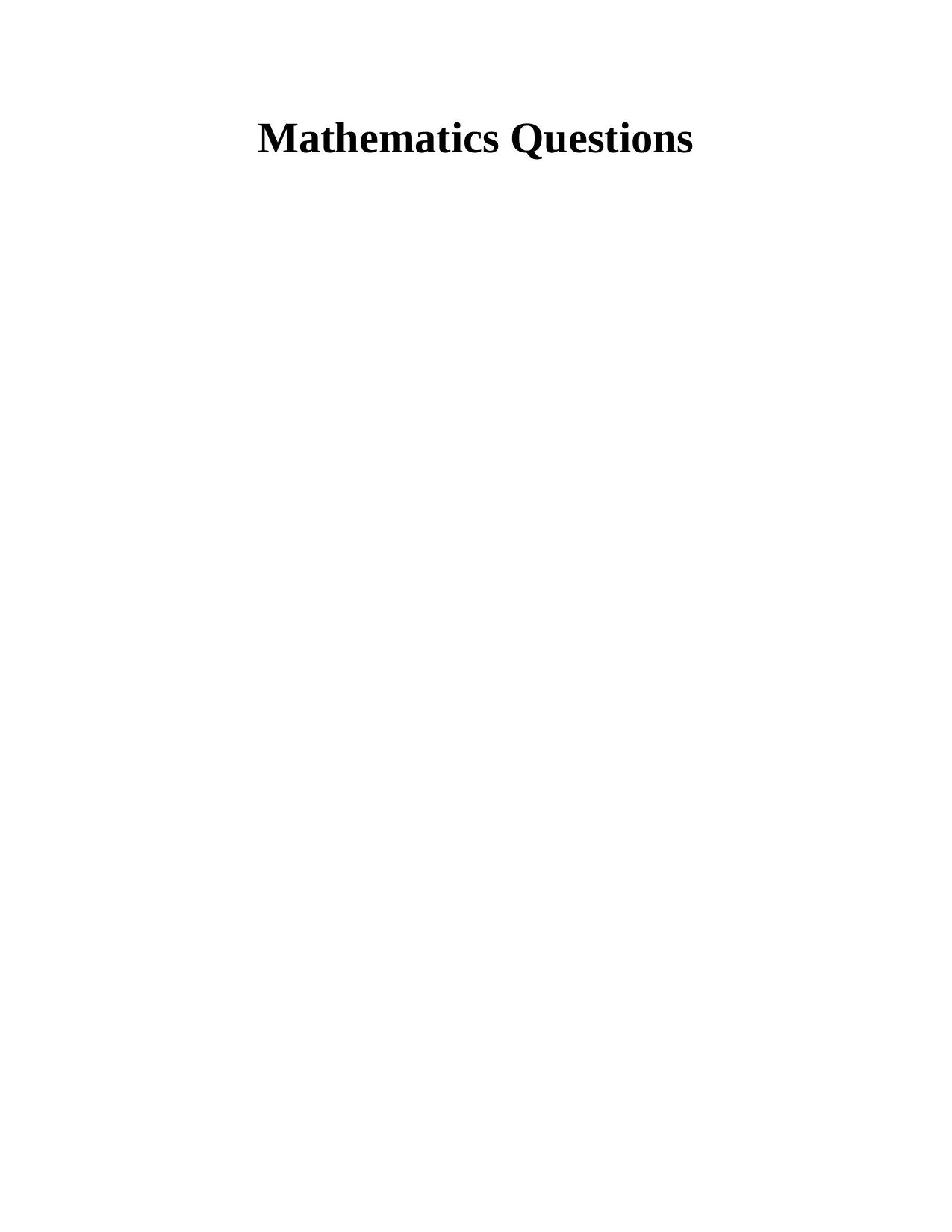
Mathematics Questions
Paraphrase This Document
Need a fresh take? Get an instant paraphrase of this document with our AI Paraphraser
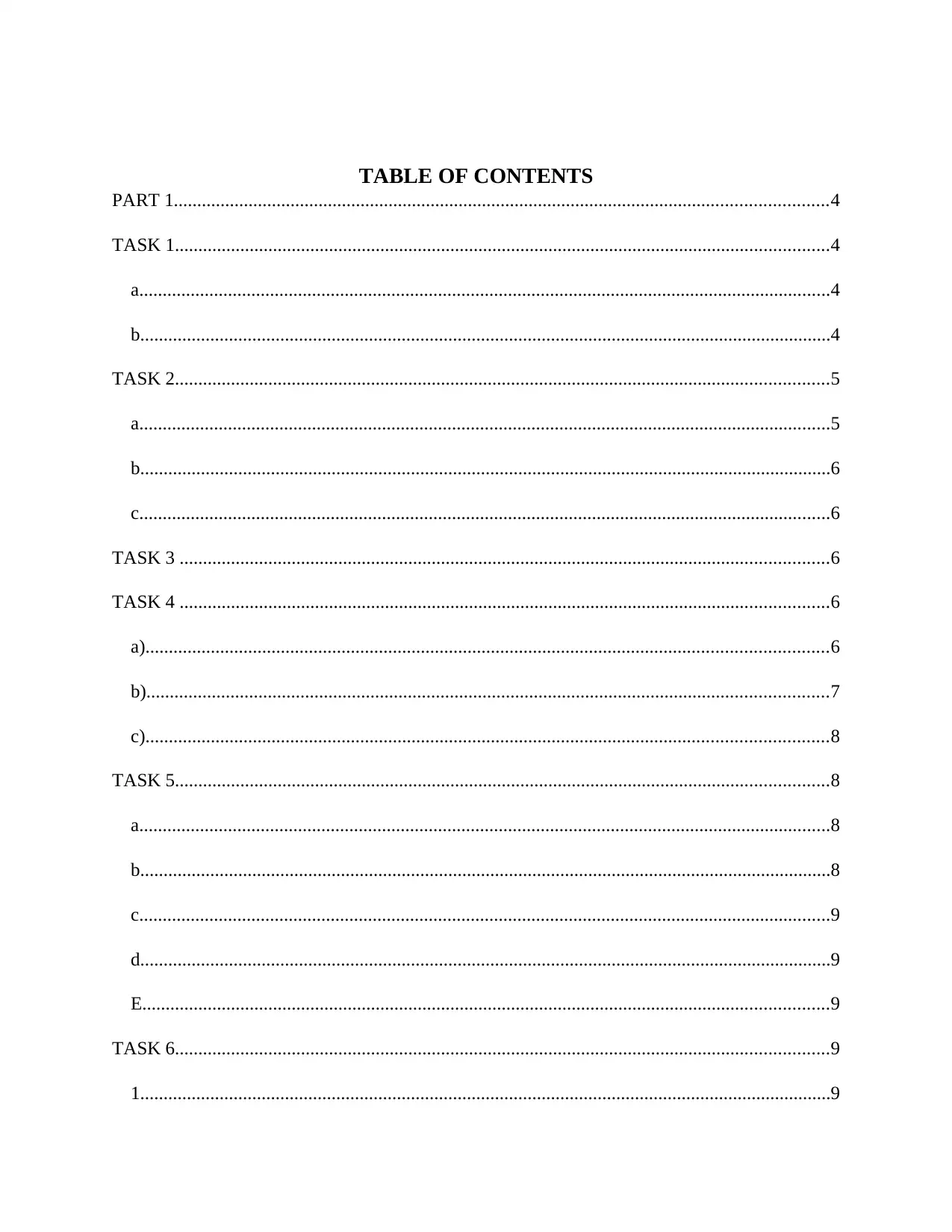
TABLE OF CONTENTS
PART 1............................................................................................................................................4
TASK 1............................................................................................................................................4
a....................................................................................................................................................4
b....................................................................................................................................................4
TASK 2............................................................................................................................................5
a....................................................................................................................................................5
b....................................................................................................................................................6
c....................................................................................................................................................6
TASK 3 ...........................................................................................................................................6
TASK 4 ...........................................................................................................................................6
a)..................................................................................................................................................6
b)..................................................................................................................................................7
c)..................................................................................................................................................8
TASK 5............................................................................................................................................8
a....................................................................................................................................................8
b....................................................................................................................................................8
c....................................................................................................................................................9
d....................................................................................................................................................9
E...................................................................................................................................................9
TASK 6............................................................................................................................................9
1....................................................................................................................................................9
PART 1............................................................................................................................................4
TASK 1............................................................................................................................................4
a....................................................................................................................................................4
b....................................................................................................................................................4
TASK 2............................................................................................................................................5
a....................................................................................................................................................5
b....................................................................................................................................................6
c....................................................................................................................................................6
TASK 3 ...........................................................................................................................................6
TASK 4 ...........................................................................................................................................6
a)..................................................................................................................................................6
b)..................................................................................................................................................7
c)..................................................................................................................................................8
TASK 5............................................................................................................................................8
a....................................................................................................................................................8
b....................................................................................................................................................8
c....................................................................................................................................................9
d....................................................................................................................................................9
E...................................................................................................................................................9
TASK 6............................................................................................................................................9
1....................................................................................................................................................9

2..................................................................................................................................................10
TASK 7..........................................................................................................................................10
PART 2..........................................................................................................................................11
1..................................................................................................................................................11
2..................................................................................................................................................11
3..................................................................................................................................................12
4..................................................................................................................................................12
5..................................................................................................................................................12
6..................................................................................................................................................13
a..................................................................................................................................................13
b..................................................................................................................................................13
c..................................................................................................................................................13
d..................................................................................................................................................13
e..................................................................................................................................................14
f..................................................................................................................................................14
REFERENCES..............................................................................................................................15
TASK 7..........................................................................................................................................10
PART 2..........................................................................................................................................11
1..................................................................................................................................................11
2..................................................................................................................................................11
3..................................................................................................................................................12
4..................................................................................................................................................12
5..................................................................................................................................................12
6..................................................................................................................................................13
a..................................................................................................................................................13
b..................................................................................................................................................13
c..................................................................................................................................................13
d..................................................................................................................................................13
e..................................................................................................................................................14
f..................................................................................................................................................14
REFERENCES..............................................................................................................................15
⊘ This is a preview!⊘
Do you want full access?
Subscribe today to unlock all pages.

Trusted by 1+ million students worldwide
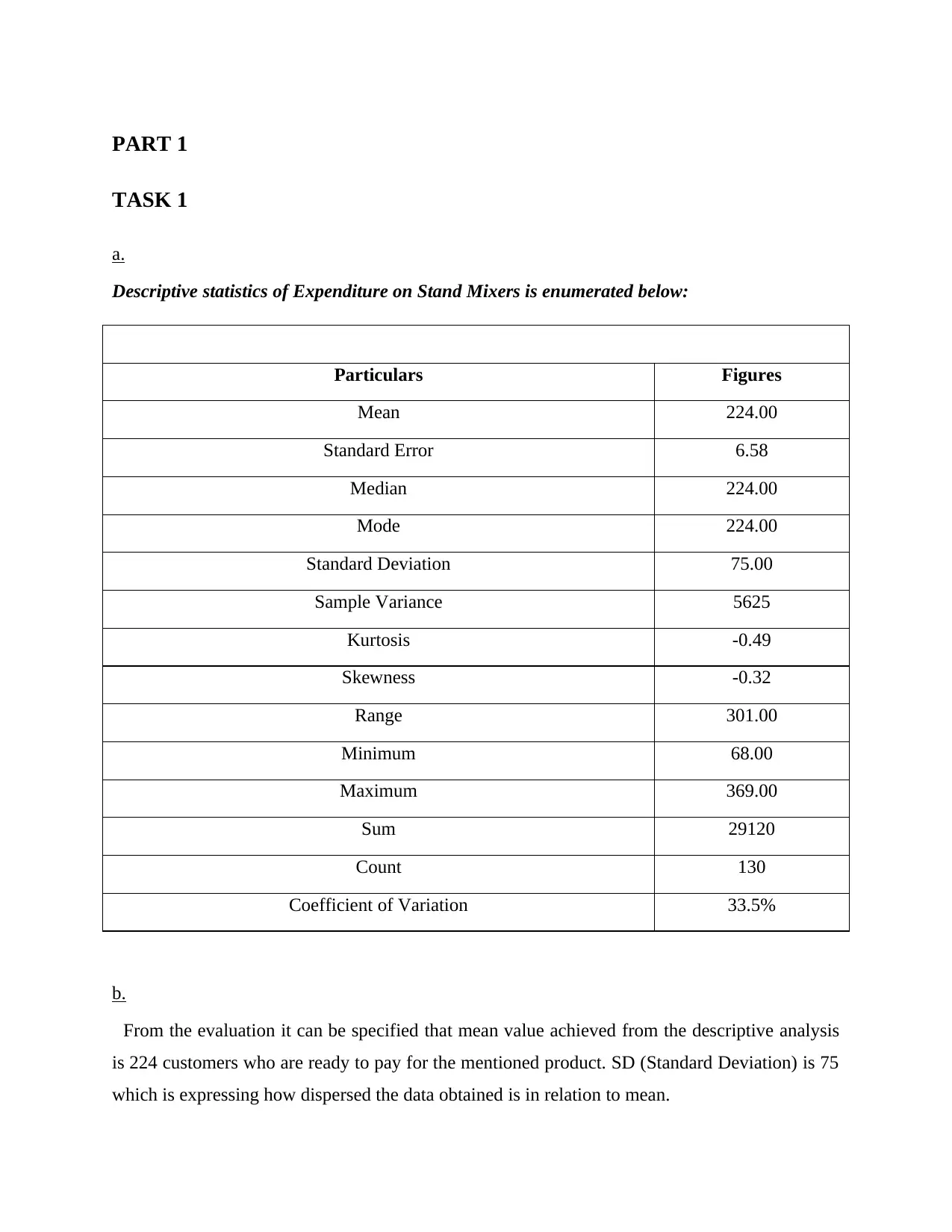
PART 1
TASK 1
a.
Descriptive statistics of Expenditure on Stand Mixers is enumerated below:
Particulars Figures
Mean 224.00
Standard Error 6.58
Median 224.00
Mode 224.00
Standard Deviation 75.00
Sample Variance 5625
Kurtosis -0.49
Skewness -0.32
Range 301.00
Minimum 68.00
Maximum 369.00
Sum 29120
Count 130
Coefficient of Variation 33.5%
b.
From the evaluation it can be specified that mean value achieved from the descriptive analysis
is 224 customers who are ready to pay for the mentioned product. SD (Standard Deviation) is 75
which is expressing how dispersed the data obtained is in relation to mean.
TASK 1
a.
Descriptive statistics of Expenditure on Stand Mixers is enumerated below:
Particulars Figures
Mean 224.00
Standard Error 6.58
Median 224.00
Mode 224.00
Standard Deviation 75.00
Sample Variance 5625
Kurtosis -0.49
Skewness -0.32
Range 301.00
Minimum 68.00
Maximum 369.00
Sum 29120
Count 130
Coefficient of Variation 33.5%
b.
From the evaluation it can be specified that mean value achieved from the descriptive analysis
is 224 customers who are ready to pay for the mentioned product. SD (Standard Deviation) is 75
which is expressing how dispersed the data obtained is in relation to mean.
Paraphrase This Document
Need a fresh take? Get an instant paraphrase of this document with our AI Paraphraser
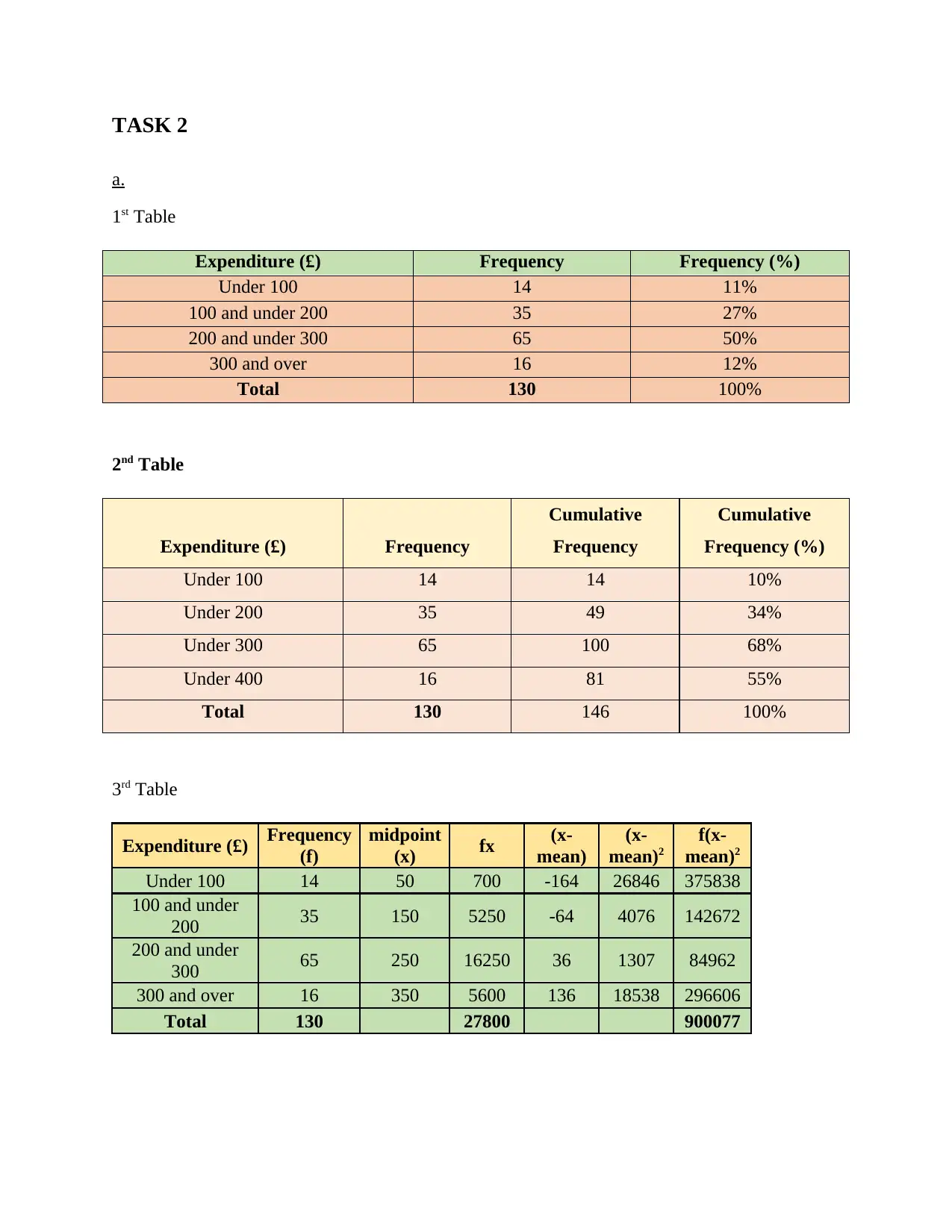
TASK 2
a.
1st Table
Expenditure (£) Frequency Frequency (%)
Under 100 14 11%
100 and under 200 35 27%
200 and under 300 65 50%
300 and over 16 12%
Total 130 100%
2nd Table
Expenditure (£) Frequency
Cumulative
Frequency
Cumulative
Frequency (%)
Under 100 14 14 10%
Under 200 35 49 34%
Under 300 65 100 68%
Under 400 16 81 55%
Total 130 146 100%
3rd Table
Expenditure (£) Frequency
(f)
midpoint
(x) fx (x-
mean)
(x-
mean)2
f(x-
mean)2
Under 100 14 50 700 -164 26846 375838
100 and under
200 35 150 5250 -64 4076 142672
200 and under
300 65 250 16250 36 1307 84962
300 and over 16 350 5600 136 18538 296606
Total 130 27800 900077
a.
1st Table
Expenditure (£) Frequency Frequency (%)
Under 100 14 11%
100 and under 200 35 27%
200 and under 300 65 50%
300 and over 16 12%
Total 130 100%
2nd Table
Expenditure (£) Frequency
Cumulative
Frequency
Cumulative
Frequency (%)
Under 100 14 14 10%
Under 200 35 49 34%
Under 300 65 100 68%
Under 400 16 81 55%
Total 130 146 100%
3rd Table
Expenditure (£) Frequency
(f)
midpoint
(x) fx (x-
mean)
(x-
mean)2
f(x-
mean)2
Under 100 14 50 700 -164 26846 375838
100 and under
200 35 150 5250 -64 4076 142672
200 and under
300 65 250 16250 36 1307 84962
300 and over 16 350 5600 136 18538 296606
Total 130 27800 900077
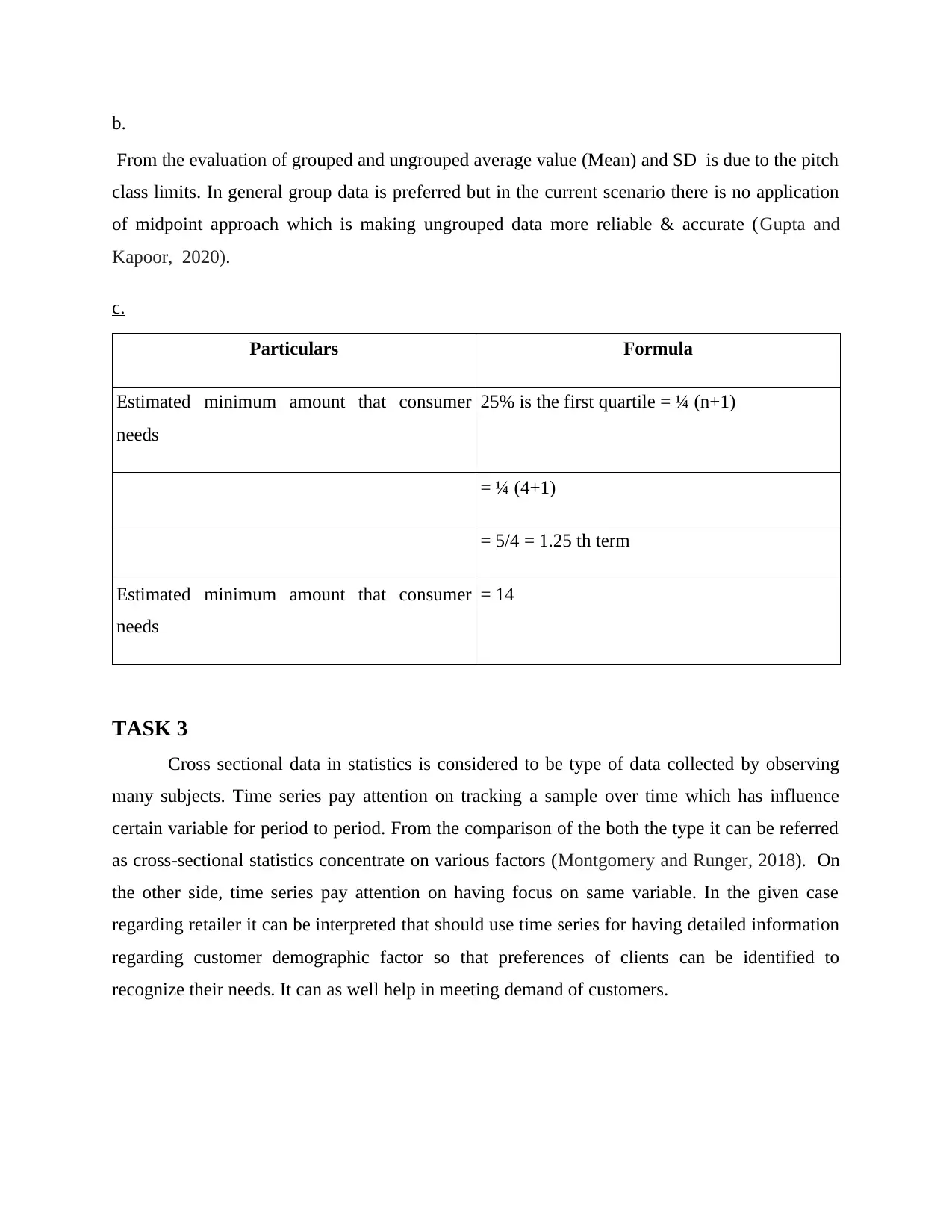
b.
From the evaluation of grouped and ungrouped average value (Mean) and SD is due to the pitch
class limits. In general group data is preferred but in the current scenario there is no application
of midpoint approach which is making ungrouped data more reliable & accurate (Gupta and
Kapoor, 2020).
c.
Particulars Formula
Estimated minimum amount that consumer
needs
25% is the first quartile = ¼ (n+1)
= ¼ (4+1)
= 5/4 = 1.25 th term
Estimated minimum amount that consumer
needs
= 14
TASK 3
Cross sectional data in statistics is considered to be type of data collected by observing
many subjects. Time series pay attention on tracking a sample over time which has influence
certain variable for period to period. From the comparison of the both the type it can be referred
as cross-sectional statistics concentrate on various factors (Montgomery and Runger, 2018). On
the other side, time series pay attention on having focus on same variable. In the given case
regarding retailer it can be interpreted that should use time series for having detailed information
regarding customer demographic factor so that preferences of clients can be identified to
recognize their needs. It can as well help in meeting demand of customers.
From the evaluation of grouped and ungrouped average value (Mean) and SD is due to the pitch
class limits. In general group data is preferred but in the current scenario there is no application
of midpoint approach which is making ungrouped data more reliable & accurate (Gupta and
Kapoor, 2020).
c.
Particulars Formula
Estimated minimum amount that consumer
needs
25% is the first quartile = ¼ (n+1)
= ¼ (4+1)
= 5/4 = 1.25 th term
Estimated minimum amount that consumer
needs
= 14
TASK 3
Cross sectional data in statistics is considered to be type of data collected by observing
many subjects. Time series pay attention on tracking a sample over time which has influence
certain variable for period to period. From the comparison of the both the type it can be referred
as cross-sectional statistics concentrate on various factors (Montgomery and Runger, 2018). On
the other side, time series pay attention on having focus on same variable. In the given case
regarding retailer it can be interpreted that should use time series for having detailed information
regarding customer demographic factor so that preferences of clients can be identified to
recognize their needs. It can as well help in meeting demand of customers.
⊘ This is a preview!⊘
Do you want full access?
Subscribe today to unlock all pages.

Trusted by 1+ million students worldwide

TASK 4
a)
Task
Mode Task Name Duration Start Finish Predecessors
1 A 6 weeks Tue 11/23/21 Mon 1/3/22
2 B 4 weeks Tue 11/23/21 Mon 12/20/21
3 C 4 weeks Tue 1/4/22 Mon 1/31/22 1
4 D 2 weeks Tue 12/21/21 Mon 1/3/22 2
5 E 6 weeks Tue 2/1/22 Mon 3/14/22 3
6 F 5 weeks Tue 2/1/22 Mon 3/7/22 3,4
7 G 3 weeks Tue 1/4/22 Mon 1/24/22 4
8 H 8 weeks Tue 11/23/21 Mon 1/17/22
9 I 5 weeks Tue 3/15/22 Mon 4/18/22 5,6,7
10 J 2 weeks Tue 4/19/22 Mon 5/2/22 8,9
a)
Task
Mode Task Name Duration Start Finish Predecessors
1 A 6 weeks Tue 11/23/21 Mon 1/3/22
2 B 4 weeks Tue 11/23/21 Mon 12/20/21
3 C 4 weeks Tue 1/4/22 Mon 1/31/22 1
4 D 2 weeks Tue 12/21/21 Mon 1/3/22 2
5 E 6 weeks Tue 2/1/22 Mon 3/14/22 3
6 F 5 weeks Tue 2/1/22 Mon 3/7/22 3,4
7 G 3 weeks Tue 1/4/22 Mon 1/24/22 4
8 H 8 weeks Tue 11/23/21 Mon 1/17/22
9 I 5 weeks Tue 3/15/22 Mon 4/18/22 5,6,7
10 J 2 weeks Tue 4/19/22 Mon 5/2/22 8,9
Paraphrase This Document
Need a fresh take? Get an instant paraphrase of this document with our AI Paraphraser
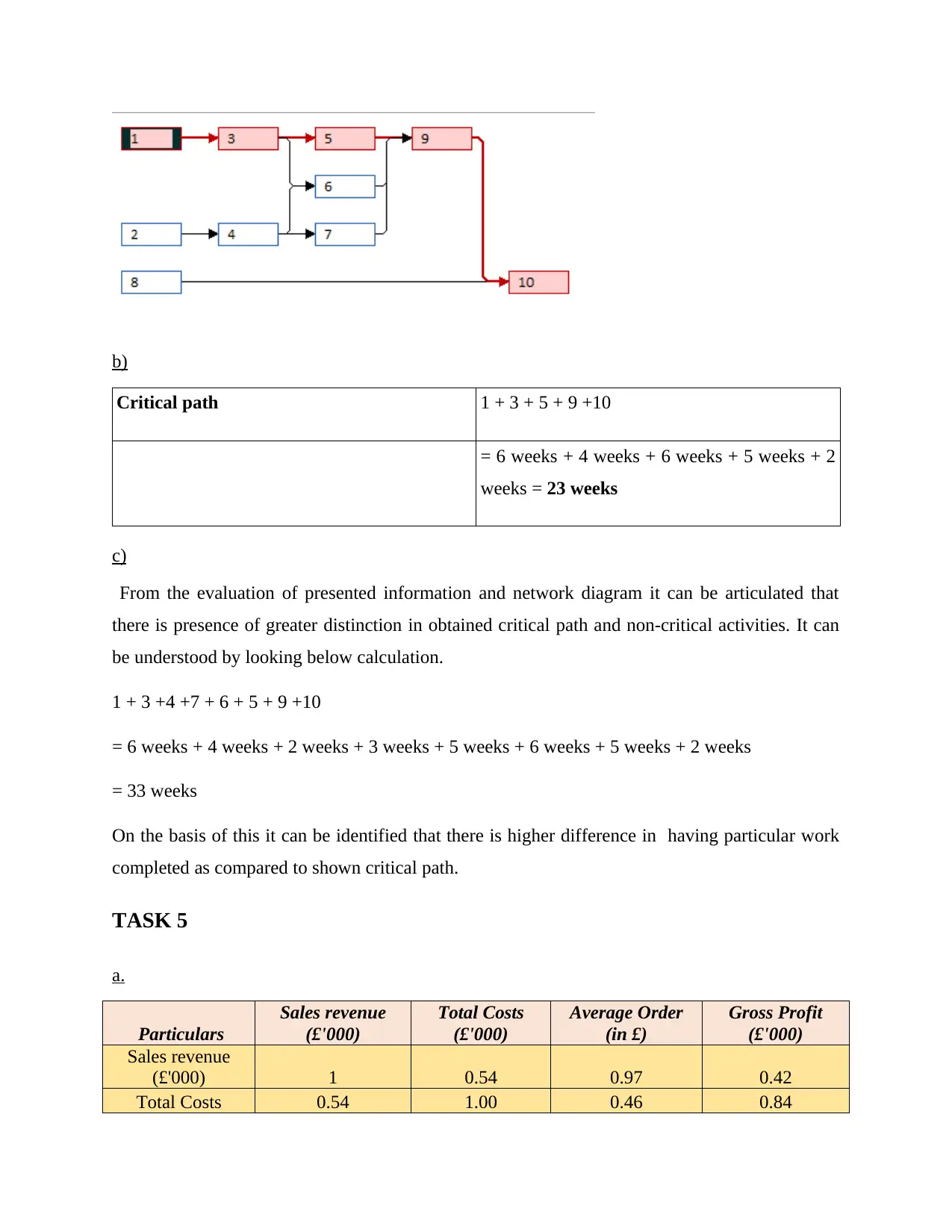
b)
Critical path 1 + 3 + 5 + 9 +10
= 6 weeks + 4 weeks + 6 weeks + 5 weeks + 2
weeks = 23 weeks
c)
From the evaluation of presented information and network diagram it can be articulated that
there is presence of greater distinction in obtained critical path and non-critical activities. It can
be understood by looking below calculation.
1 + 3 +4 +7 + 6 + 5 + 9 +10
= 6 weeks + 4 weeks + 2 weeks + 3 weeks + 5 weeks + 6 weeks + 5 weeks + 2 weeks
= 33 weeks
On the basis of this it can be identified that there is higher difference in having particular work
completed as compared to shown critical path.
TASK 5
a.
Particulars
Sales revenue
(£'000)
Total Costs
(£'000)
Average Order
(in £)
Gross Profit
(£'000)
Sales revenue
(£'000) 1 0.54 0.97 0.42
Total Costs 0.54 1.00 0.46 0.84
Critical path 1 + 3 + 5 + 9 +10
= 6 weeks + 4 weeks + 6 weeks + 5 weeks + 2
weeks = 23 weeks
c)
From the evaluation of presented information and network diagram it can be articulated that
there is presence of greater distinction in obtained critical path and non-critical activities. It can
be understood by looking below calculation.
1 + 3 +4 +7 + 6 + 5 + 9 +10
= 6 weeks + 4 weeks + 2 weeks + 3 weeks + 5 weeks + 6 weeks + 5 weeks + 2 weeks
= 33 weeks
On the basis of this it can be identified that there is higher difference in having particular work
completed as compared to shown critical path.
TASK 5
a.
Particulars
Sales revenue
(£'000)
Total Costs
(£'000)
Average Order
(in £)
Gross Profit
(£'000)
Sales revenue
(£'000) 1 0.54 0.97 0.42
Total Costs 0.54 1.00 0.46 0.84

(£'000)
Average Order
(in £) 0.97 0.46 1.00 0.34
Gross Profit
(£'000) 0.42 0.84 0.34 1.00
b.
Particulars (£'000)
Best Predictor Sales revenue
The main reason behind identifying this particular aspect is that there is greater amount of
association with each rather than other components reflected.
c.
d.
From the provided information it can be specified that there is occurrence of 17% change in
dependent variable. The change obtained in dependent variable when there is any change in
Average Order
(in £) 0.97 0.46 1.00 0.34
Gross Profit
(£'000) 0.42 0.84 0.34 1.00
b.
Particulars (£'000)
Best Predictor Sales revenue
The main reason behind identifying this particular aspect is that there is greater amount of
association with each rather than other components reflected.
c.
d.
From the provided information it can be specified that there is occurrence of 17% change in
dependent variable. The change obtained in dependent variable when there is any change in
⊘ This is a preview!⊘
Do you want full access?
Subscribe today to unlock all pages.

Trusted by 1+ million students worldwide
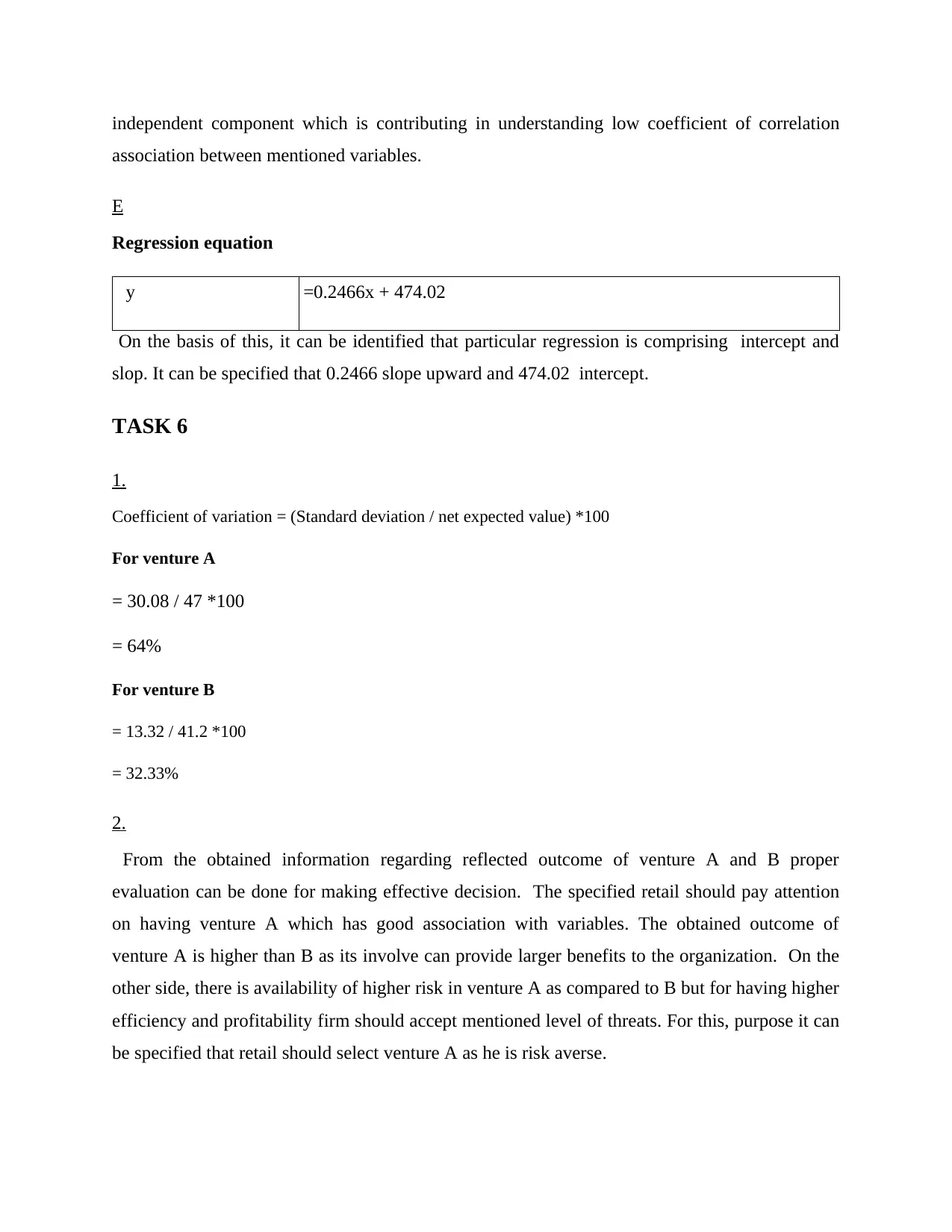
independent component which is contributing in understanding low coefficient of correlation
association between mentioned variables.
E
Regression equation
y =0.2466x + 474.02
On the basis of this, it can be identified that particular regression is comprising intercept and
slop. It can be specified that 0.2466 slope upward and 474.02 intercept.
TASK 6
1.
Coefficient of variation = (Standard deviation / net expected value) *100
For venture A
= 30.08 / 47 *100
= 64%
For venture B
= 13.32 / 41.2 *100
= 32.33%
2.
From the obtained information regarding reflected outcome of venture A and B proper
evaluation can be done for making effective decision. The specified retail should pay attention
on having venture A which has good association with variables. The obtained outcome of
venture A is higher than B as its involve can provide larger benefits to the organization. On the
other side, there is availability of higher risk in venture A as compared to B but for having higher
efficiency and profitability firm should accept mentioned level of threats. For this, purpose it can
be specified that retail should select venture A as he is risk averse.
association between mentioned variables.
E
Regression equation
y =0.2466x + 474.02
On the basis of this, it can be identified that particular regression is comprising intercept and
slop. It can be specified that 0.2466 slope upward and 474.02 intercept.
TASK 6
1.
Coefficient of variation = (Standard deviation / net expected value) *100
For venture A
= 30.08 / 47 *100
= 64%
For venture B
= 13.32 / 41.2 *100
= 32.33%
2.
From the obtained information regarding reflected outcome of venture A and B proper
evaluation can be done for making effective decision. The specified retail should pay attention
on having venture A which has good association with variables. The obtained outcome of
venture A is higher than B as its involve can provide larger benefits to the organization. On the
other side, there is availability of higher risk in venture A as compared to B but for having higher
efficiency and profitability firm should accept mentioned level of threats. For this, purpose it can
be specified that retail should select venture A as he is risk averse.
Paraphrase This Document
Need a fresh take? Get an instant paraphrase of this document with our AI Paraphraser
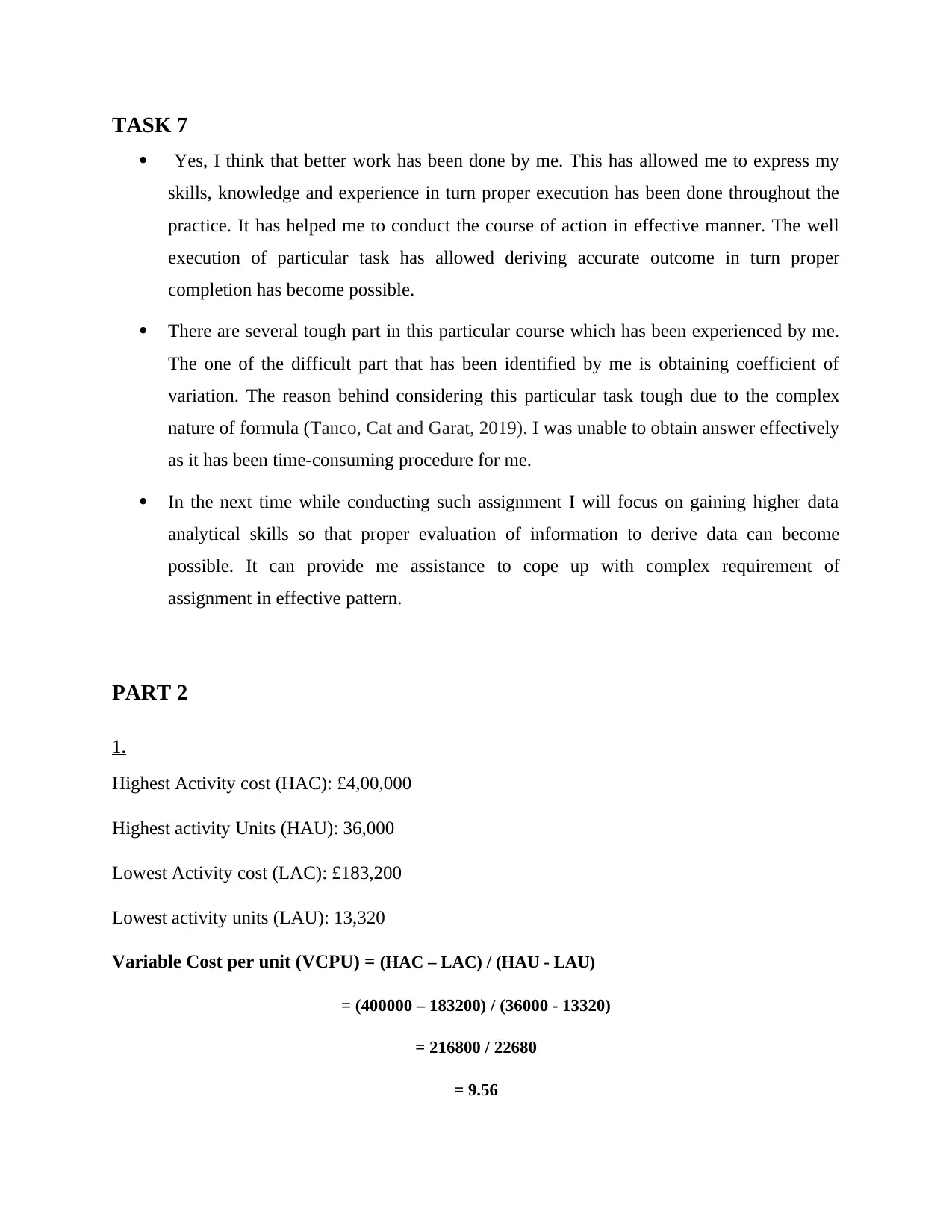
TASK 7
Yes, I think that better work has been done by me. This has allowed me to express my
skills, knowledge and experience in turn proper execution has been done throughout the
practice. It has helped me to conduct the course of action in effective manner. The well
execution of particular task has allowed deriving accurate outcome in turn proper
completion has become possible.
There are several tough part in this particular course which has been experienced by me.
The one of the difficult part that has been identified by me is obtaining coefficient of
variation. The reason behind considering this particular task tough due to the complex
nature of formula (Tanco, Cat and Garat, 2019). I was unable to obtain answer effectively
as it has been time-consuming procedure for me.
In the next time while conducting such assignment I will focus on gaining higher data
analytical skills so that proper evaluation of information to derive data can become
possible. It can provide me assistance to cope up with complex requirement of
assignment in effective pattern.
PART 2
1.
Highest Activity cost (HAC): £4,00,000
Highest activity Units (HAU): 36,000
Lowest Activity cost (LAC): £183,200
Lowest activity units (LAU): 13,320
Variable Cost per unit (VCPU) = (HAC – LAC) / (HAU - LAU)
= (400000 – 183200) / (36000 - 13320)
= 216800 / 22680
= 9.56
Yes, I think that better work has been done by me. This has allowed me to express my
skills, knowledge and experience in turn proper execution has been done throughout the
practice. It has helped me to conduct the course of action in effective manner. The well
execution of particular task has allowed deriving accurate outcome in turn proper
completion has become possible.
There are several tough part in this particular course which has been experienced by me.
The one of the difficult part that has been identified by me is obtaining coefficient of
variation. The reason behind considering this particular task tough due to the complex
nature of formula (Tanco, Cat and Garat, 2019). I was unable to obtain answer effectively
as it has been time-consuming procedure for me.
In the next time while conducting such assignment I will focus on gaining higher data
analytical skills so that proper evaluation of information to derive data can become
possible. It can provide me assistance to cope up with complex requirement of
assignment in effective pattern.
PART 2
1.
Highest Activity cost (HAC): £4,00,000
Highest activity Units (HAU): 36,000
Lowest Activity cost (LAC): £183,200
Lowest activity units (LAU): 13,320
Variable Cost per unit (VCPU) = (HAC – LAC) / (HAU - LAU)
= (400000 – 183200) / (36000 - 13320)
= 216800 / 22680
= 9.56
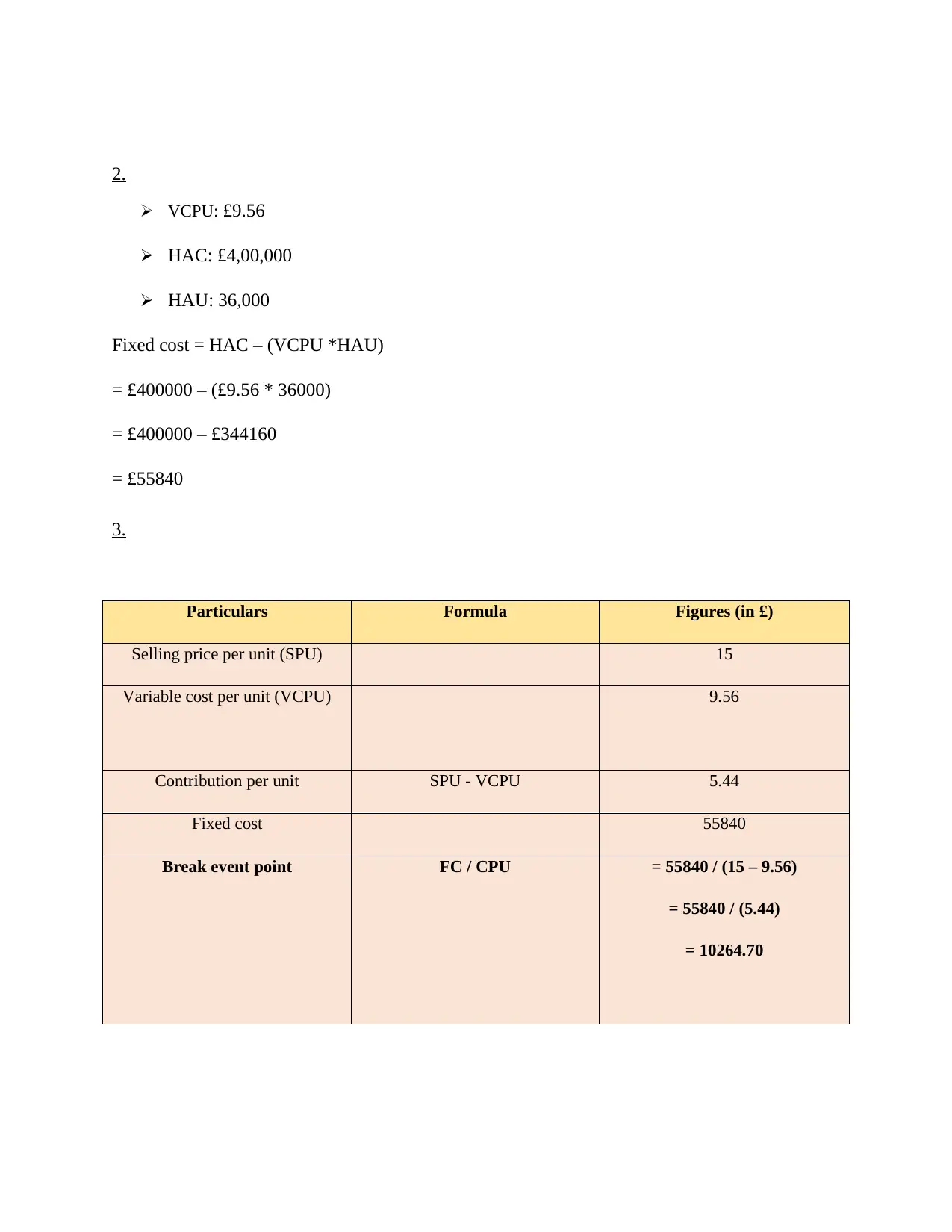
2.
VCPU: £9.56
HAC: £4,00,000
HAU: 36,000
Fixed cost = HAC – (VCPU *HAU)
= £400000 – (£9.56 * 36000)
= £400000 – £344160
= £55840
3.
Particulars Formula Figures (in £)
Selling price per unit (SPU) 15
Variable cost per unit (VCPU) 9.56
Contribution per unit SPU - VCPU 5.44
Fixed cost 55840
Break event point FC / CPU = 55840 / (15 – 9.56)
= 55840 / (5.44)
= 10264.70
VCPU: £9.56
HAC: £4,00,000
HAU: 36,000
Fixed cost = HAC – (VCPU *HAU)
= £400000 – (£9.56 * 36000)
= £400000 – £344160
= £55840
3.
Particulars Formula Figures (in £)
Selling price per unit (SPU) 15
Variable cost per unit (VCPU) 9.56
Contribution per unit SPU - VCPU 5.44
Fixed cost 55840
Break event point FC / CPU = 55840 / (15 – 9.56)
= 55840 / (5.44)
= 10264.70
⊘ This is a preview!⊘
Do you want full access?
Subscribe today to unlock all pages.

Trusted by 1+ million students worldwide
1 out of 15
Related Documents
Your All-in-One AI-Powered Toolkit for Academic Success.
+13062052269
info@desklib.com
Available 24*7 on WhatsApp / Email
![[object Object]](/_next/static/media/star-bottom.7253800d.svg)
Unlock your academic potential
Copyright © 2020–2025 A2Z Services. All Rights Reserved. Developed and managed by ZUCOL.





